Top 10 AI tools for content writers
AI tools can make your content creation easier. But which ones are the best? Let’s find your perfect match—here are my top ten picks to help boost creativity and productivity.
Written by Tereza Bruzkova

AI tools can make your content creation easier. But which ones are the best? Let’s find your perfect match—here are my top ten picks to help boost creativity and productivity.
Written by Tereza Bruzkova

AI tools can make content creation faster, easier, and more consistent by helping with ideas, structure, visuals, and even optimization. They’re great for saving time and tackling creative blocks, but don’t forget to maintain the human touch, since your voice, experience, and empathy are what make content feel real and connect with readers.
In this blog, we’ll cover the following tools that can help you throughout your content creation journey, from ideation to optimization:
Scroll horizontally to see more →
AI can boost creativity and efficiency: Tools like Copy.ai, Rytr, and Kontent.ai help you write faster, refine ideas, and improve consistency.
Visuals and SEO matter too: Canva, Pictory, Descript, and Surfer SEO show how AI supports not just writing but also visuals, videos, and optimization.
Keep your human touch: Use AI to assist, not replace your creativity, experience, and empathy. That’s what makes your content stand out.
I’ve tried out numerous AI tools to help me get past writer’s block and save time when producing content. It’s true that artificial intelligence can make your life easier, particularly if you’re a content creator who could use some help when you’re stuck or have a deadline to meet.
Nowadays, AI-generated content is everywhere—and in some cases, it’s not that difficult to tell. The human element is still necessary for every high-quality piece of content, even with the great assistance of AI tools for content writing. The trick is to find the right balance.
AI writing tools and tools for content creation in general can assist with repetitive tasks or provide a spark of inspiration. It gives you the boost you need to begin writing or editing your text, letting your creative side take over and focus on crafting valuable content.
90% of marketers use AI for faster decision-making. Source: surveymonkey.com
So, which AI assistants have become my go-to sources for writing assistance? Here are the top ten AI tools that I use in my work and recommend trying.
If you write on a daily basis, you’re likely familiar with Grammarly. If not, you might want to keep reading. This AI-powered writing assistant is a huge help when it comes to polishing up my writing and spotting those typos that always seem to sneak into the text.
Grammarly catches those pesky spelling mistakes and grammatical errors. The tool analyzes your word choice, sentence structure, and overall readability, offering suggestions to improve clarity, conciseness, and engagement.
If you want to be sure the copy aligns with your brand and will resonate with your target audience, Grammarly has you covered.
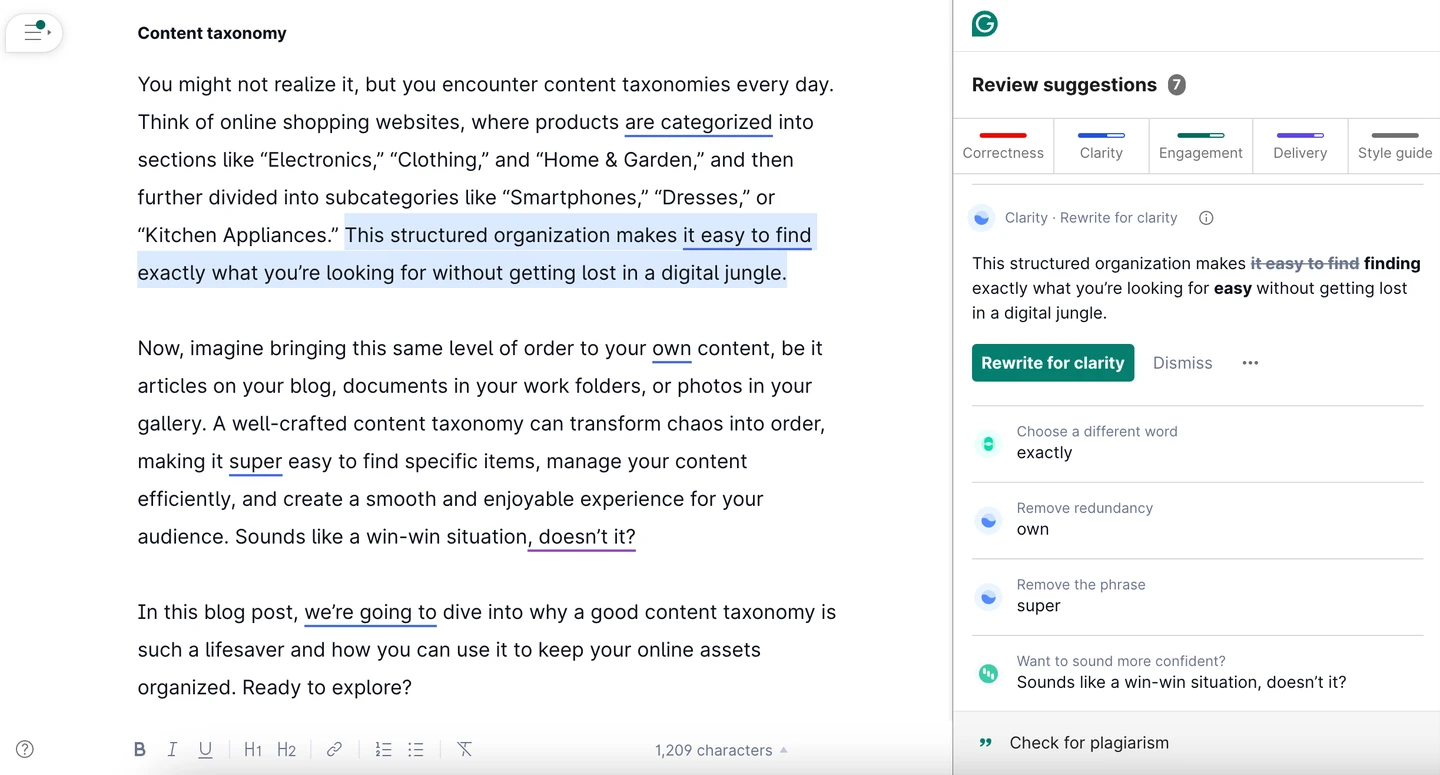
Its real-time recommendations come in handy, especially when working with limited time. Grammarly highlights errors and offers solutions to help ensure that my writing is clear and error-free.
Navigating through the recommendations and selecting which changes to accept is made simple by the user-friendly design. And the best part? It is compatible with Google Docs, Microsoft Office, and your web browser, so you can use it almost anywhere you write.
When you work on your content in your preferred setting, you can take advantage of its style recommendations and proofreading services. No need to switch between different applications. Just write and edit on the go.
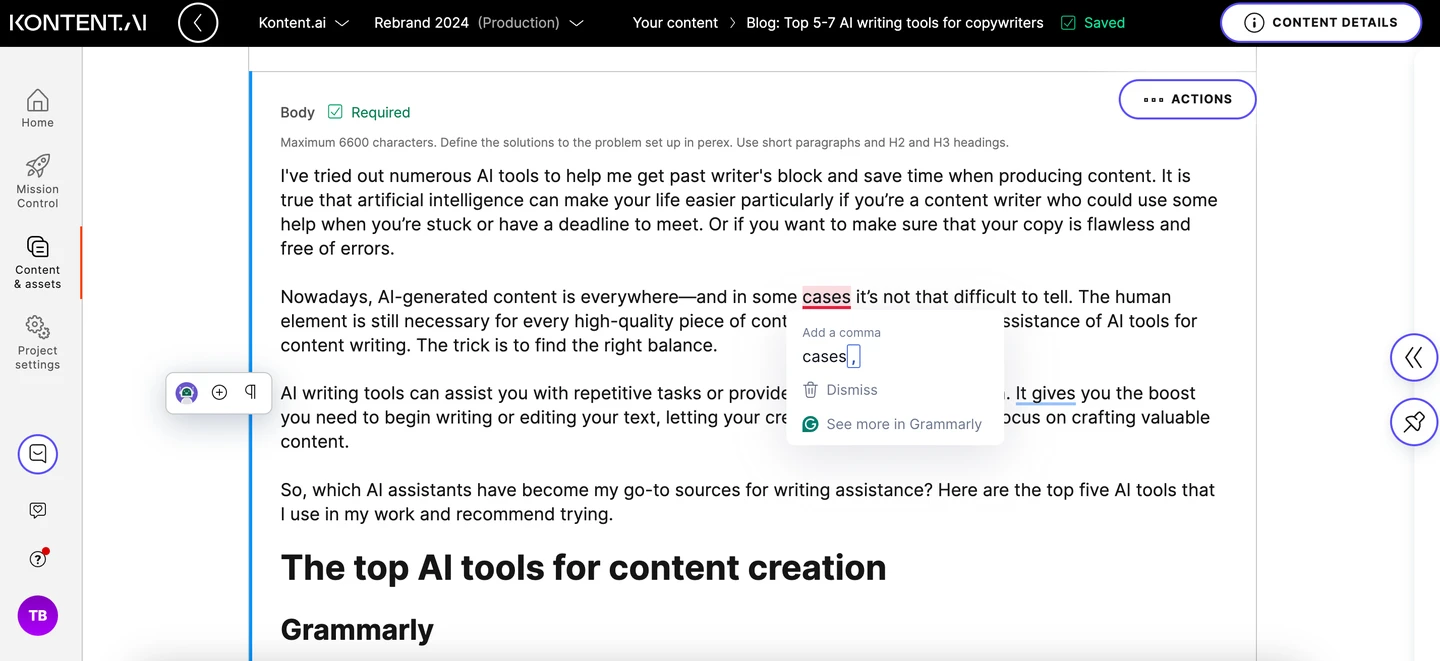
So, is there any con to this super helpful tool? It might not always offer the best recommendation in particular situations. Even though the tool is extremely sophisticated, it is still an AI system, and in most situations, you still need to rely on your judgment and experience to reach a decision.
Overall, Grammarly is a great tool for content creators who want to create high-quality, error-free, and excellent content. It is worth trying out, regardless of your level of experience writing content. The free version is surprisingly feature-rich, and it’s also simple to use.
Pros:
Cons:
Copy.ai is like a reliable friend who always knows what to do. Need to follow up on a webinar? It handles that for you by summarizing the transcript and crafting customized thank you and follow-up emails.
Alternatively, Copy.ai can be used to repurpose an old blog post into content that is appropriate for all of your channels. This tool can write all sorts of things, from blog titles to social media posts, just by giving it a starting point.
Copy.ai provides templates for almost all marketing requirements.Their AI platform, which is intended for marketing teams, offers more than 90 content templates and tools, such as email subject lines, sales emails, blog post outlines and introductions, and product descriptions.
One of the Copy.ai features that stand out is the ability to generate content in various tones and styles, which allows you to tailor the output to your brand’s voice and target audience.
You can go one step further and indicate the length of your copy, the keywords you want to use, and the format you want.
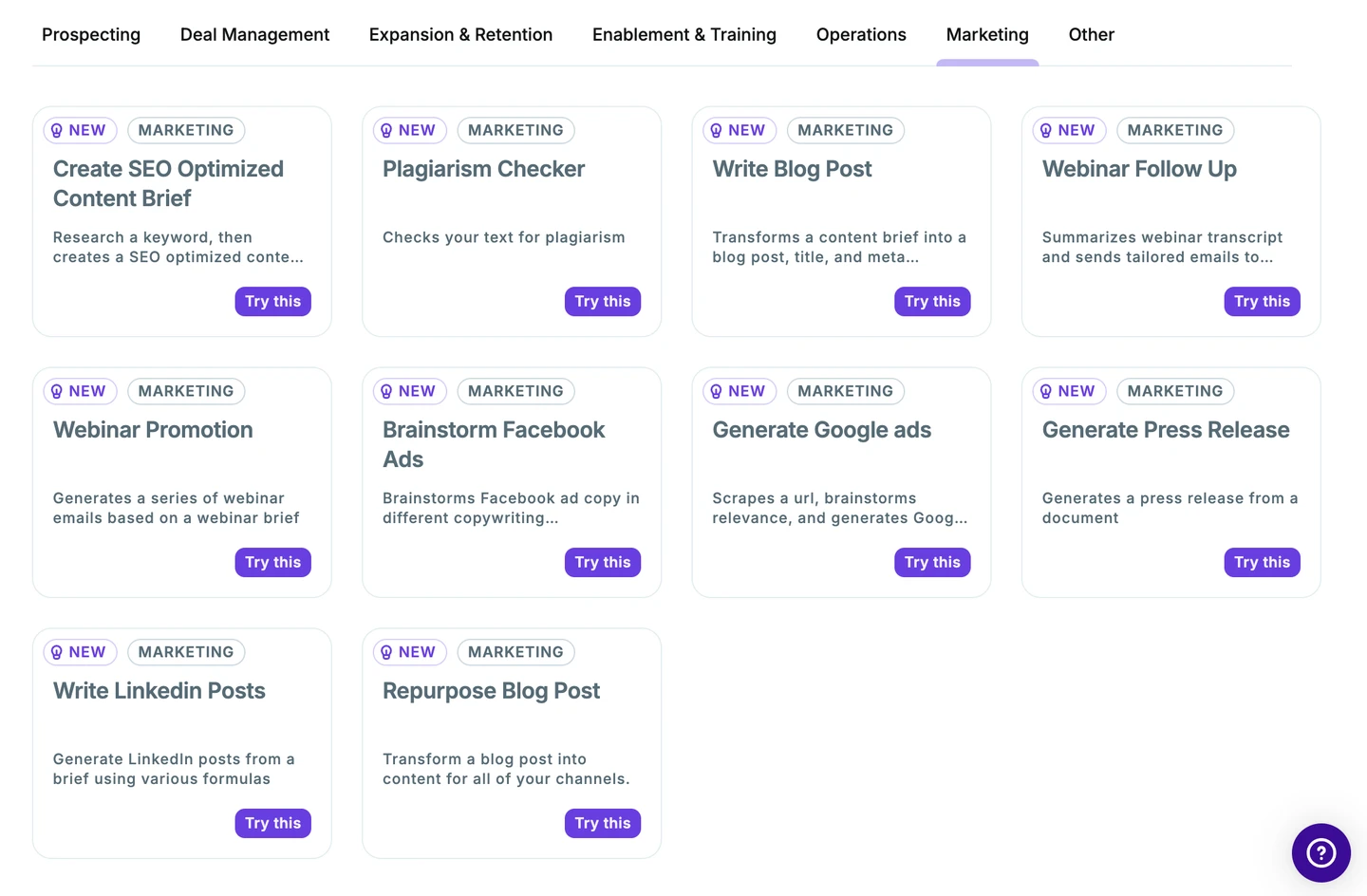
The only drawback is that Copy.ai requires in-app work because it lacks a browser extension. This means that you will have to spend some time copying files from the tool to your workspace.
As for the free version, a single user of Copy.ai can produce up to 2,000 words per month. In any case, you will most likely need to upgrade if you intend to use it frequently for work.
All things considered, Copy.ai is a fantastic tool since it’s quick and allows me to write more without compromising my creativity.
Pros:
Cons:
What I love about Rytr is how easy and fun it is to use. It lets you pick the tone of voice you want, whether it’s casual, enthusiastic, or convincing. I give it a topic or a few keywords, and it quickly produces a strong first draft that I can then tweak and improve.
Rytr also provides a wide range of intriguing use cases. In addition to the standard ones like blog idea & outline, it also has a job description, a story plot, a keywords generator, the ability to respond to reviews and messages, and a magic command, which works literally like magic.
The copy generated by Rytr sounds quite natural and compelling, compared to the results I would get from ChatGPT. It picks up on my choices and recommendations.
I don’t have to be concerned about coming across as impersonal or generic because Rytr helps me create content that is engaging and authentic.
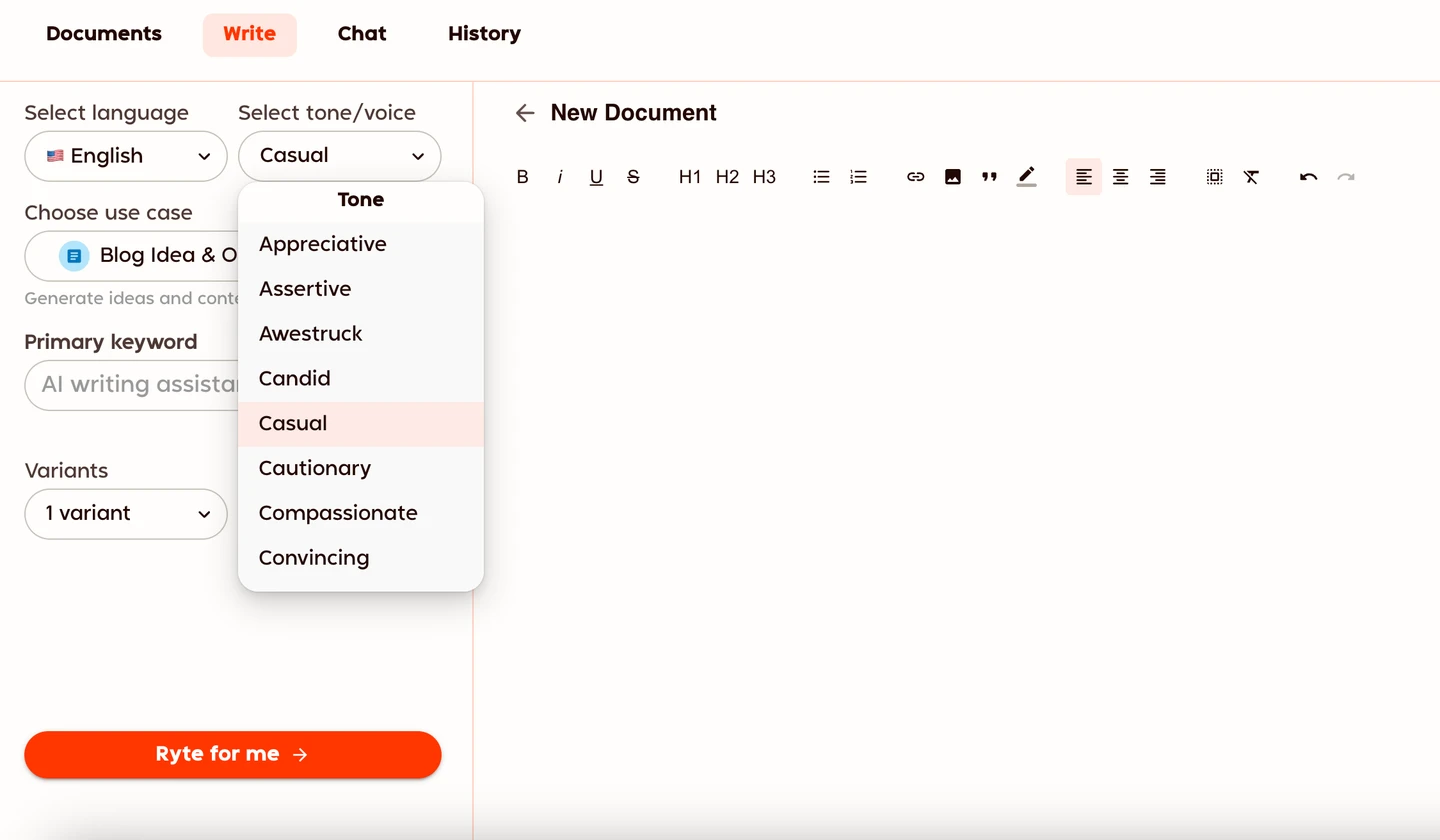
The ability to select the level of creativity (from optimal to max) and generate up to three versions of the desired text is another fantastic feature of Rytr that I really like. It allows you to experiment with the copy, offering a variety of options to select from and then refine as necessary.
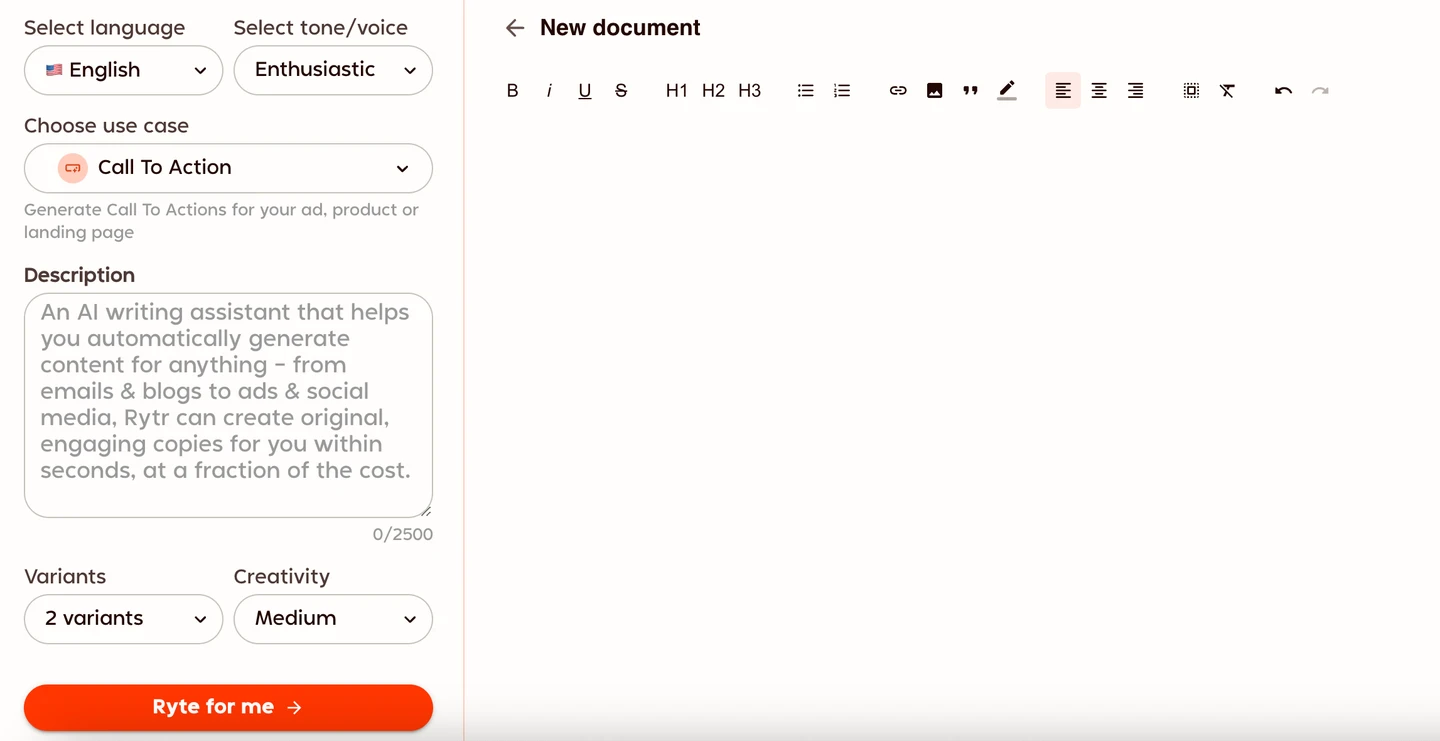
Are there any drawbacks? The main cons I’ve found are that the free plan has limited features and the paid plans can be somewhat expensive for individual creators.
Pros:
Cons:
The productivity-enhancing AI features in Kontent.ai are my favorite. Having the AI integrated directly into the content platform saves a lot of time since I don’t have to switch between different tabs.
I can simply type in a request or select a block of existing text and ask the AI to adjust the tone, improve the content, or shorten it as needed. Knowing that I can rely on Kopilot, Kontent.ai’s smart assistant, to quickly transform a blank page into a first draft helps me keep it cool when starting a blog post.
For more intricate tasks, I simply provide direct instructions in the Kontent.ai app and see the results right away. Whenever I need to come up with a catchy title, I use the AI features right within the app. Based on what I’ve written, I get the best possible title.
Plus, having the option to summarize the entire page or just a selected part makes it so much easier to grab the key points and final thoughts. It is a great way to transform existing content into social media posts, ads, or even website content.
The AI in Kontent.ai is incredibly useful for creating localized image descriptions. It assists me in defining alt text for images, which is essential for describing pictures to those who can’t see them, whether due to technical issues or accessibility needs. Moreover, it also helps boost SEO rankings.
Another thing that makes Kontent.ai stand out is their commitment to Responsible AI, which means you can leverage artificial intelligence without compromising ethics or security—you can focus on creativity, knowing that the AI has your back on the technical and ethical front.
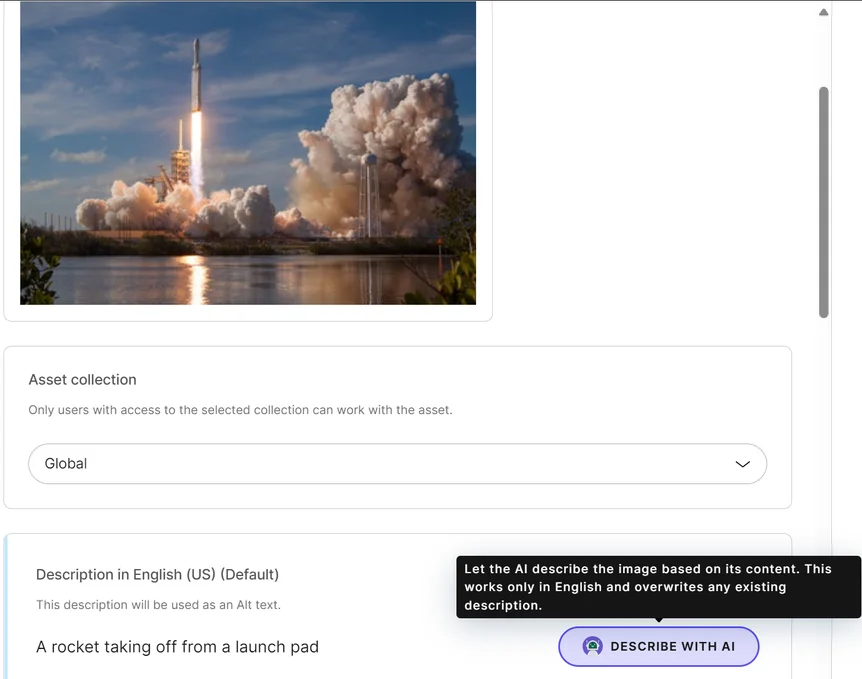
Are there any cons? It’s worth noting there is a bit of a learning curve when it comes to maximizing the full potential of Kontent.ai’s AI skills. It took me a little while to get comfortable with everything, but once I did, I found the platform’s AI to be incredibly helpful.
Pros:
Cons:
Google’s Gemini is one of the best AI writing assistants. I rely on it daily, both professionally and personally, for everything from research and translation to brainstorming and writing.
Gemini excels in writing and content generation with its impressive ability to understand context and produce text that feels human-like. It allows you to create high-quality content, whether it’s a blog post or a technical document.
I also appreciate the hints and suggestions it provides to enhance my writing, as well as its range of options, from concise to more detailed responses.
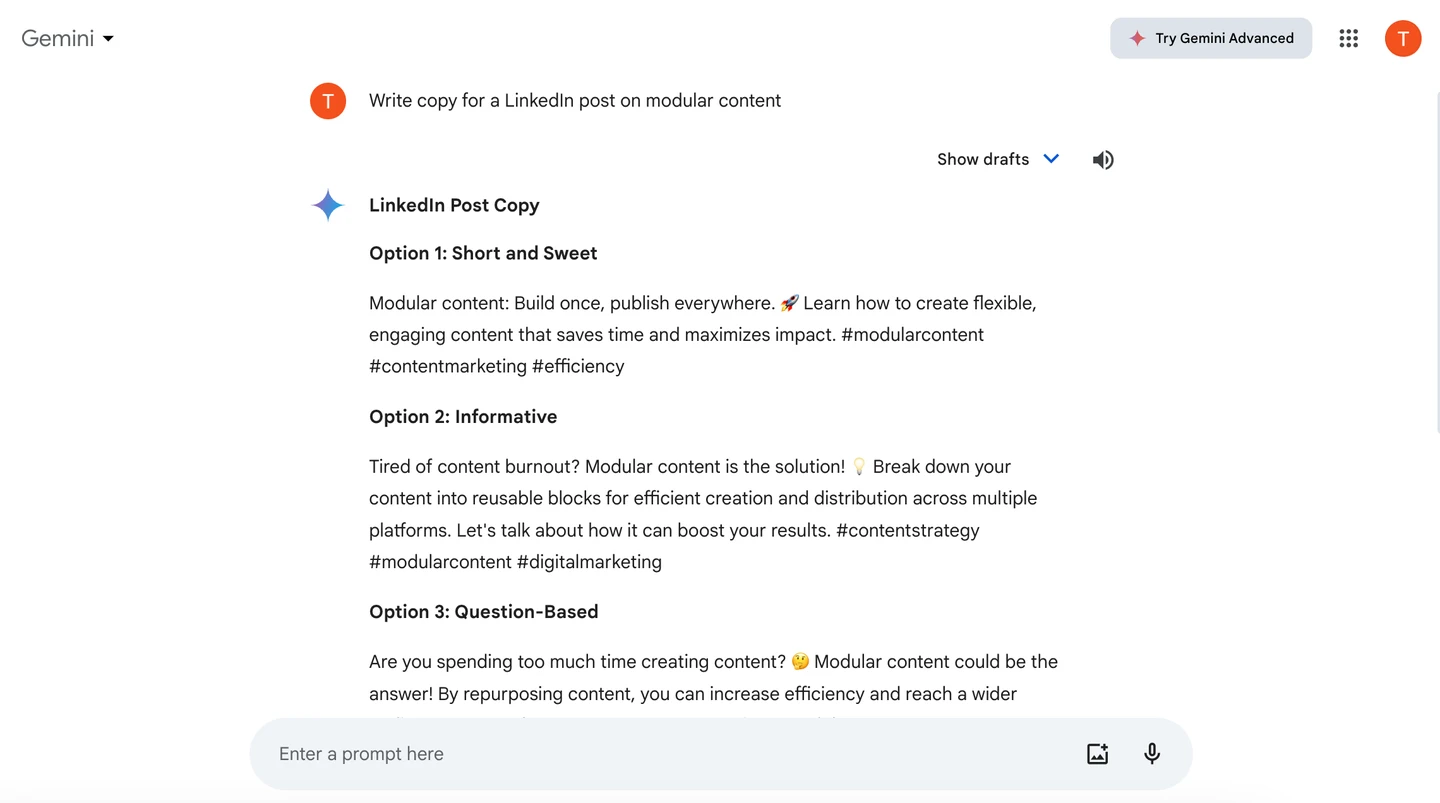
I give Gemini an extra point for its visual appeal. The generated text is neatly formatted into bullet points through an intuitive, user-friendly interface.
This makes it easy to quickly review the content, especially when time is tight. Plus, the text remains clear, informal, and free of the fluff I often see with ChatGPT.
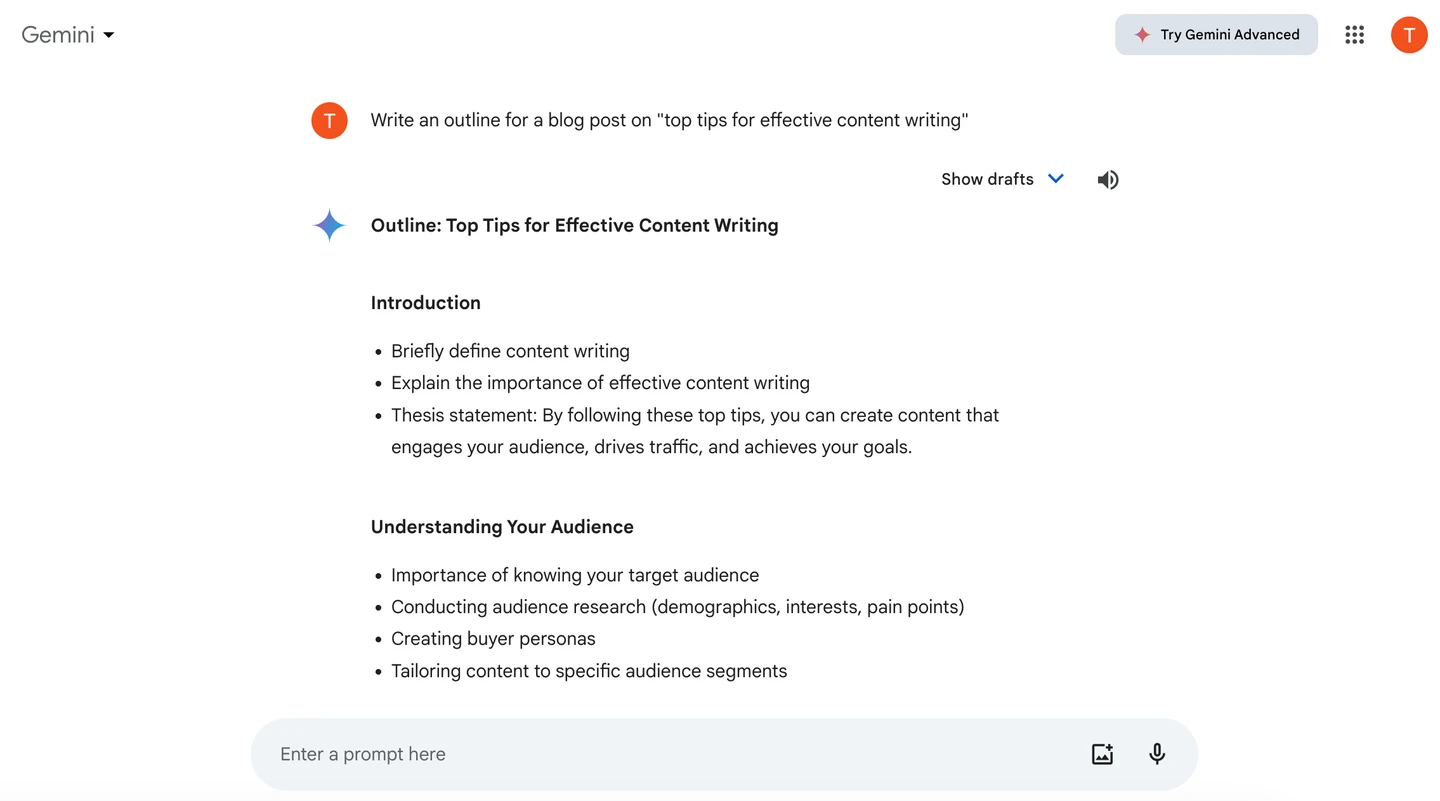
Pros:
Cons:
Canva is a design platform that makes creating visuals much less intimidating. It’s built for people who don’t necessarily have a background in graphic design but still want to make good-looking graphics.
A big pro is that Canva has ready-made templates to get you started, no matter if you need a banner for your blog, an infographic to break up text, or a social media image.
For content writers, Canva is a great way to give your words more impact. A well-placed graphic can make an article easier to read and more appealing to share.
If you want to highlight a quote, create a thumbnail, or illustrate a key idea, Canva helps you do that without needing advanced design software. Its AI features like Magic Write and background removal make the process faster and smoother.

Another nice thing is that Canva lets you keep your branding consistent. You can save your preferred fonts, colors, and logos so everything you create has the same look and feel.
It’s easy to drag and drop elements, and you can export designs in just a few clicks. This is especially handy if you work on multiple content projects and want a cohesive look across them.
The great thing is that Canva isn’t just for static images, it also has simple video editing features. You can trim clips, add text overlays, include transitions, and even use stock video or music to create short videos.
This means you can turn blog posts, social media ideas, or presentations into engaging video content without learning complicated editing software. It’s a quick way to make your content more dynamic and shareable.
Pros:
Cons:
Pictory is a tool that turns written content into videos. Instead of learning complicated video editing software, you can simply paste in your blog post or script, and Pictory will pick out the key points and build a video around them.
It adds visuals, captions, and even voiceovers automatically, which saves a lot of time. For writers, this can be especially useful if you want to reach people who prefer watching over reading.
A well-made short video can summarize your article and make it easier to share on platforms like LinkedIn, Instagram, or YouTube. It’s a practical way to get more out of the content you already have without creating something entirely new from scratch.
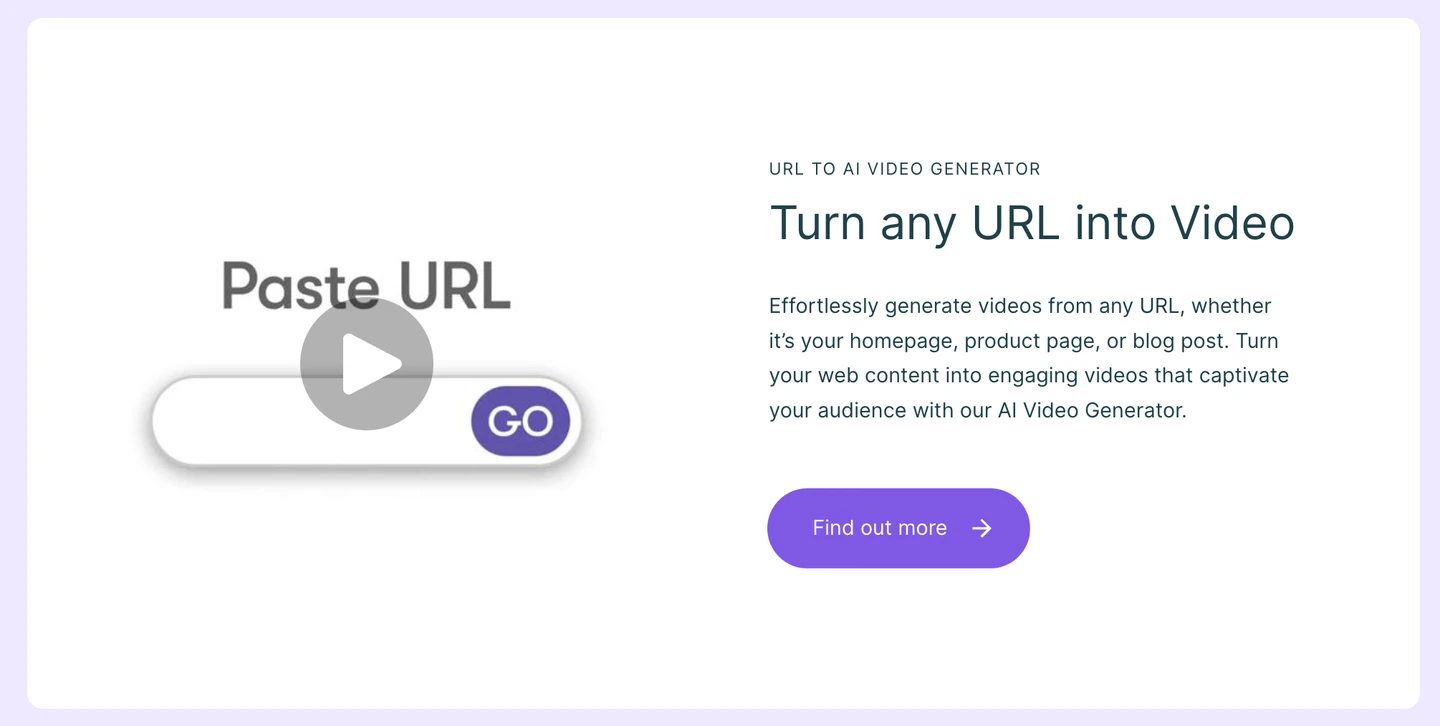
Pictory also helps if you’re not comfortable with editing. The platform does most of the heavy lifting for you. You can make small tweaks, but you don’t need to be a pro to get good results. It’s a helpful companion for writers who want to bring their stories to life in more than one format.
Pros:
Cons:
Descript is a unique tool that makes editing audio and video feel like editing a document. You can record yourself, upload a file, or start with a transcript.
Then, instead of using complex editing timelines, you simply delete or change text in the transcript, and the audio or video updates automatically to match. For content writers, this is great if you’re branching out into podcasts, webinars, or video tutorials.
It removes a lot of the friction that comes with editing media. You can easily cut out filler words, silence, or awkward moments without needing to learn traditional editing software. It’s especially handy if you want to repurpose interviews or recordings into clean, polished pieces.
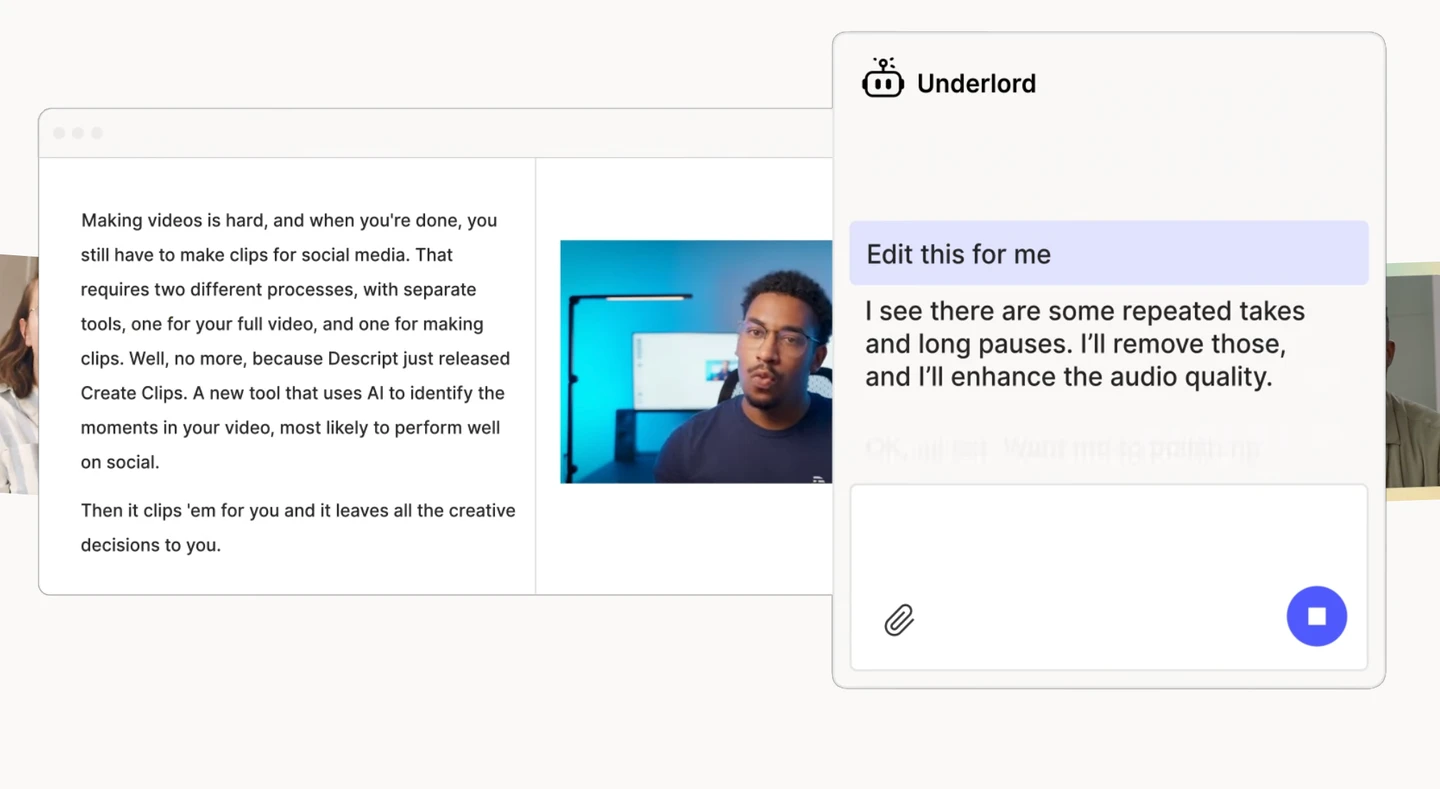
Descript also comes with built-in transcription and captioning, which can make your content more accessible. If you are someone who wants to tell stories in different formats, then Descript might be worth trying.
Pros:
Cons:
Surfer SEO is a tool that helps writers create content that can rank better on search engines like Google. Instead of guessing what might work, Surfer looks at the pages that already rank well for your chosen keyword and shows you what they have in common.
It gives practical suggestions like how many words to write, how often to use certain keywords, and how to structure your article with headings and subheadings. For content writers, this means you can focus on writing while letting the tool handle the technical SEO side.
You don’t have to be an SEO expert to use it. Surfer gives you a simple score that updates in real time as you write, so you can see if you’re on the right track. It also provides a content brief that outlines what to cover, making it easier to start a new article without a blank page.
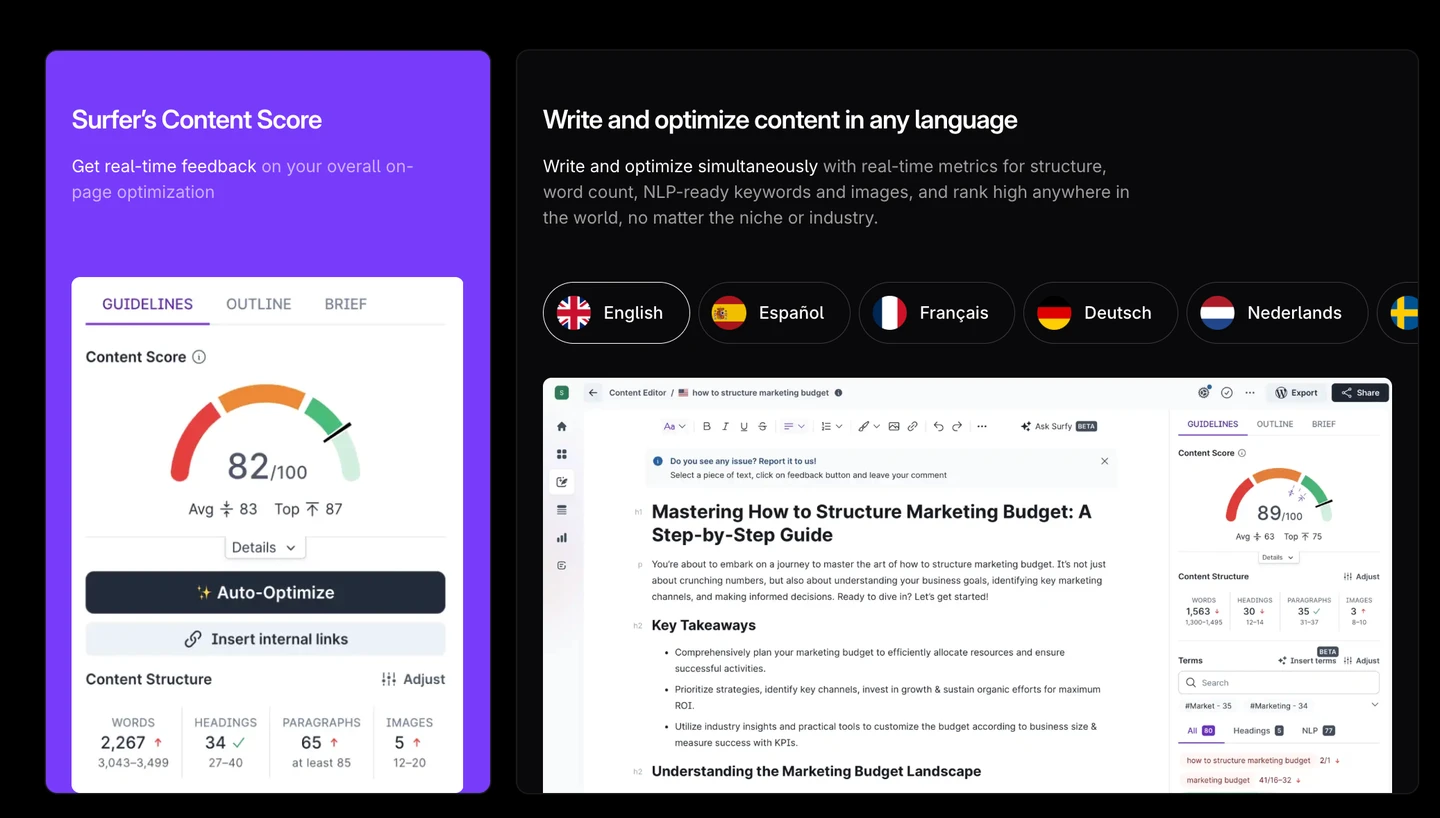
Pros:
Cons:
65% of companies have noted better SEO results when using AI. Source: semrush.com
Outranking is an AI-powered content and SEO platform designed to make planning and writing easier. It looks at what’s already ranking on Google for your topic and uses that information to help you outline and structure your piece.
Instead of starting with a blank page, you get a suggested framework with key points and headings. For content writers, this can save a lot of time in the early stages of writing.
It helps you figure out what to cover, how long your piece should be, and how to use keywords naturally. Outranking also analyzes search intent, meaning it gives you clues about what people actually want when they search for that topic.
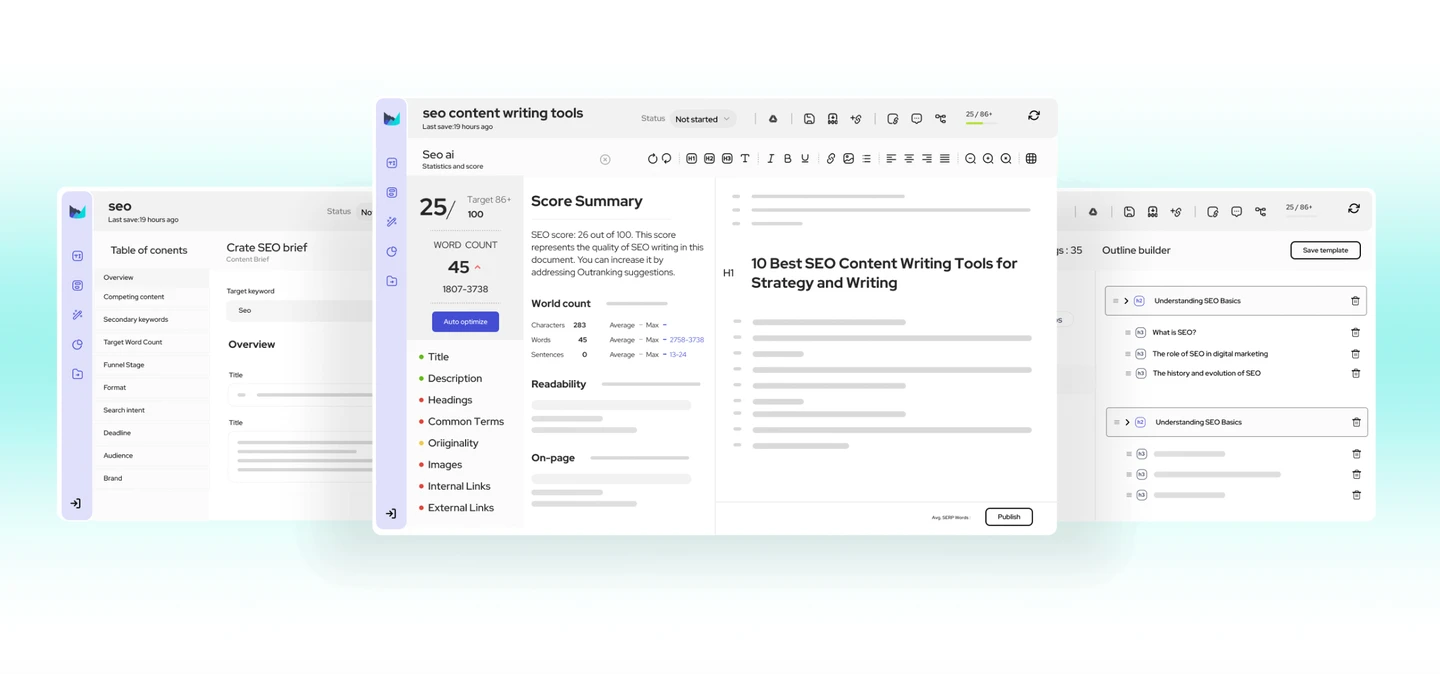
This tool can help with improving drafts, too. It provides recommendations for making your content more readable and SEO-friendly without losing your natural tone. That’s a big plus if you want your work to perform better in search results but don’t want to get lost in technical SEO jargon.
Pros:
Cons:
To make this list useful, I focused on how each AI tool can actually help content writers in their day-to-day work. The tools were chosen and ranked based on a few key factors:
In this post, I shared ten AI tools that I personally use, and that can greatly enhance the productivity of anyone working with content. AI can speed up content creation, automate repetitive tasks, and help with creative blocks. Still, human creativity is key to making truly outstanding content.
Keep in mind that AI is a tool, not a replacement. Always review AI-generated content carefully to make sure it fits your brand voice and adds real value for readers. The key to success is using AI effectively while keeping that human touch.
If you want to explore the relationship between human professionals and AI in today’s digital era of content creation, you can do that in our interactive resource:

What if we told you there was a way to make your website a place that will always be relevant, no matter the season or the year? Two words—evergreen content. What does evergreen mean in marketing, and how do you make evergreen content? Let’s dive into it.
Lucie Simonova

How can you create a cohesive experience for customers no matter what channel they’re on or what device they’re using? The answer is going omnichannel.
Zaneta Styblova

To structure a blog post, start with a strong headline, write a clear introduction, and break content into short paragraphs. Use descriptive subheadings, add visuals, and format for easy scanning. Don’t forget about linking and filling out the metadata. Want to go into more detail? Dive into this blog.
Lucie Simonova
For a free AI writing tool, Grammarly, Kontent.ai, and Rytr are excellent choices. Grammarly helps with grammar, spelling, and clarity, Kontent.ai provides AI-powered content suggestions and editing directly inside its platform, and Rytr can generate drafts and ideas.